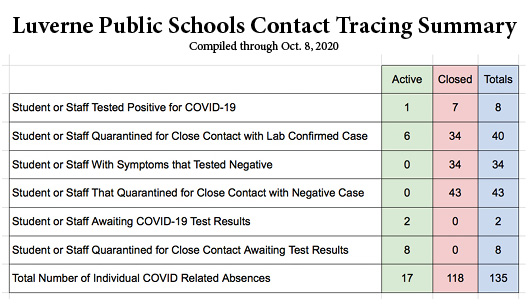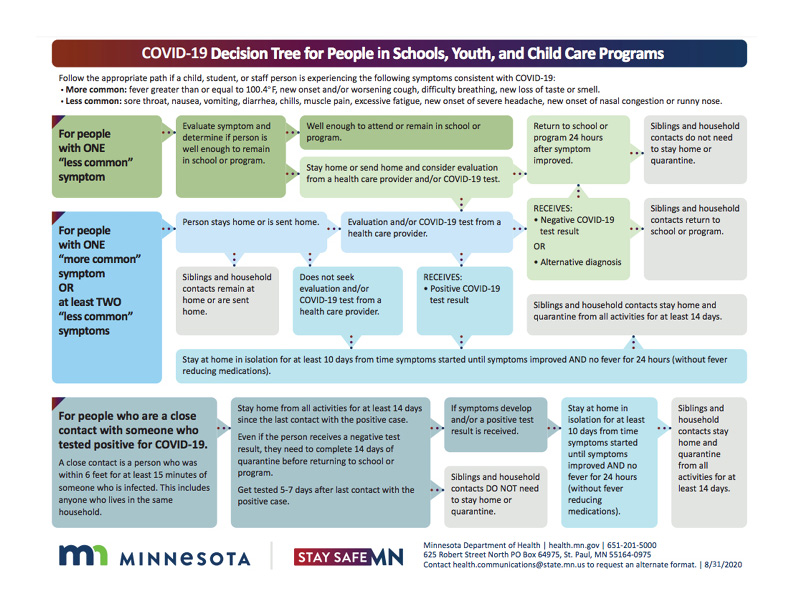 ,
, 
It’s been a challenging start to the 2020-21 school year for the Luverne district where learning resumed amid a major construction project and a pandemic health threat.
With the “hybrid learning model” elementary students attend in-person classes every day while the middle-high school students are split into two groups, alternating days of in-person learning at school and distance learning from home.
With personal health a top priority, school nurse Phil Paquette and administrators faced a myriad of unknowns.
“There were a lot of questions going into the school year,” Paquette said.
Among them were:
•Would positive COVID-19 cases increase as a result of school opening?
•Could the district meet state social distance requirements of six feet of space between students on buses as well as in the classrooms?
Within a week, school officials were getting affirmative answers.
“Two or three weeks ago we started seeing the numbers rise in our area,” Paquette said. “[We] had a few positive cases within the school, but — in the end of that — no confirmed spread within the school.”
COVID-related absences within school low
Out of the 1,200 students and about 225 staff in the Luverne School district, there is one active case of COVID-19, according to the school contact-tracing summary through Oct. 8.
Seven positive cases have been closed.
In the first four weeks of school, 135 staff or students were not in school due to a COVID-related absence.
The low numbers are attributed to following state health guidelines, Paquette said.
“The students have been truly amazing in following the guidelines of wearing their masks, working on the social distancing piece and they are truly and honestly excited to be here,” Paquette said.
“The staff has been great too about following the guidelines, working with their students through these issues and just settling into a good routine.”
Luverne implemented state protocols “to a “T,” Superintendent Craig Oftedahl told board members at the Sept. 24 meeting.
Paquette has helped implement those protocols.
“Teachers and students are able to use the space that we do have to properly social distance in classrooms,” he said.
“Having the students and staff masked while in the building has been huge and working normal hand hygiene into the daily routine as well has been very good.”
Elementary principal Stacy Gillette told board members that modified hallway transitions have reduced student congestion between class periods. Hand sanitizer is available in every classroom, and additional cleaning occurs throughout the day. This includes wiping tables after lunch sessions, which have doubled.
“We now have six lunch periods and that gets to be a lot,” Gillette said.
‘Decision tree’ provides attendance guidelines
The Minnesota Department of Health developed a “decision tree” flow chart, which outlines courses of action based on minor and major symptoms of COVID-19.
The chart also suggests potential treatment and/or quarantine for students and other family members in the household.
“One of the biggest things about COVID-19 is that it is so new. We don’t have an active vaccination or immunization against it and we don’t know the long-term effects of it. We’re learning new things about it all the time,” Paquette said
“Where with some seasonal illnesses, take the flu for example, things like that have been around for decades, centuries in some instances … we know a lot more about them and their long-term effects. Whereas with COVID, we are still learning what the effects are of it, what the infectiousness of it is, how quickly it spreads through the population.”
Paquette attends weekly Thursday meetings with a local incident response team of county officials, health professionals, teachers, administrators and parents.
The team shares information about the latest COVID-19 numbers and addresses school and community questions within the group.
“Coming into the school year, you feel at times like you’re on your own and trying to work through these problems,” Paquette said.
“So between our local health care providers and regional health team in the Department of Health, we’ve had a lot of great resources out there to make you feel you’re not alone in this — you’re not the only school district dealing with it.”
Oftedahl said the weekly dialogue focuses on “what makes sense” to keep students, staff and school safe.
Because of the virus’s unpredictability both the elementary and middle-high school are preparing for the potential change in learning models.
Distance learning being prepared if necessary
If deemed necessary to prevent the spread of COVID-19, the district will suspend all in-person learning and move to distancing learning where students attend classes electronically from home.
Chrome Books will be distributed to students in second- through fifth grade in anticipation for distance learning.
“We’ll try to get kids connected to technology in case we have to change learning models,” Gillette said.
High School Principal Ryan Johnson said secondary teachers encourage students to bring their own electronic devices to school and, for students who do not have a device, the district checked out 174 Chrome Books to students.
Currently about 10 middle-high school teachers are working with a synchronous model of instruction, where at-home and in-person students participate at the same time with live-streamed lectures.
“This year will be the kickoff to offering that,” Johnson said.
Live interaction appears to help keep students engaged in learning from home and moving forward with their studies.
“Kids at home, for the most part, are checking in instead of checking out,” Johnson said.
In March, when the coronavirus pandemic was declared, school districts were mandated over a two-week period to come up with a distance-learning plan. The last two months of the 2019-20 school year were completed using the newly developed distance learning format.
Due to the abrupt change in learning methods from in-person to distance learning, some students didn’t or couldn’t check in daily with teachers.
This year the attendance process was tightened as a result of the middle and high school students rotating through the hybrid-learning days.
“Students are expected to check in during their scheduled period live stream, log into Google Classroom, (and) work on learning tasks,” Johnson also told board members.
Middle School Principal Jason Phelps said middle school students that are off-campus are expected to be online at 1:45 p.m. for a grade-level meeting with teachers.
He said the majority of teachers are using an “A-B model” for instruction where they teach in-person lessons to the “A” or “red group” and then repeat the same lesson the next day for the “B” or “white group.”
“But we have some — primarily math teachers — that have started real-time instruction with off-campus students,” Phelps said.
The district is currently working on a hybrid learning website for parents as a reference for daily tasks students should complete.
Learning models continue for now
For now, Luverne will continue in-person learning at the elementary school and hybrid method at the middle-high school.
Paquette will continue the daily contact tracing of COVID-19-related absences among staff and students.
“Even if we feel great about what we know now, it can quickly change and the numbers and cases can go up and down quite quickly,” he said.
“So we always need to be vigilant about that, operate between the guidelines and take the precautions necessary — especially not only here at school but in the community so that we can keep numbers down and stay in-person at school.
Parents receive COVID-19 resources; screen at home
By Mavis Fodness
Stay at home when you’re not feeling well.
That’s the advice Luverne school nurse Phil Paquette has stressed since the 2020-21 school year started a month ago.
“This is one of the greatest ways to stop the spread of not only COVID-19 but other illnesses as well,” he said. “Parents have been doing a great job of system screening at home.”
The Minnesota Department of Health developed a series of guidelines for parents, which Paquette shared last month with each family within the school district.
The guidelines include screening questions parents can ask their children and a course of action if any of the symptoms are present.
Many of the guidelines have community application also.
“We are still learning about how different age groups are affected by it and there is no immunization or vaccination to protect us against it,” Paquette said.
The guidelines available online are as follows:
https://www.health.state.mn.us/diseases/coronavirus/schools/homescreen…
https://www.health.state.mn.us/diseases/coronavirus/schools/exguide.pdf
https://www.health.state.mn.us/diseases/coronavirus/schools/attendance…
https://www.health.state.mn.us/communities/mentalhealth/support.html


